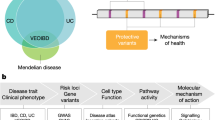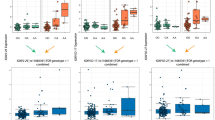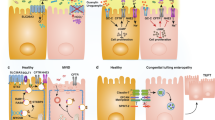Abstract
The intestinal flora has long been thought to play a role either in initiating or in exacerbating the inflammatory bowel diseases (IBD). Host defenses, such as those mediated by the Toll-like receptors (TLR), are critical to the host/pathogen interaction and have been implicated in IBD pathophysiology. To explore the association of genetic variation in TLR pathways with susceptibility to IBD, we performed a replication study and pooled analyses of the putative IBD risk alleles in NFKB1 and TLR4, and we performed a haplotype-based screen for association to IBD in the TLR genes and a selection of their adaptor and signaling molecules. Our genotyping of 1539 cases of IBD and pooled analysis of 4805 cases of IBD validates the published association of a TLR4 allele with risk of IBD (odds ratio (OR): 1.30, 95% confidence interval (CI): 1.15–1.48; P=0.00017) and Crohn's disease (OR: 1.33, 95% CI: 1.16–1.54; P=0.000035) but not ulcerative colitis. We also describe novel suggestive evidence that TIRAP (OR: 1.16, 95% CI: 1.04–1.30; P=0.007) has a modest effect on risk of IBD. Our analysis, therefore, offers additional evidence that the TLR4 pathway – in this case, TLR4 and its signaling molecule TIRAP – plays a role in susceptibility to IBD.
This is a preview of subscription content, access via your institution
Access options
Subscribe to this journal
Receive 6 digital issues and online access to articles
$119.00 per year
only $19.83 per issue
Buy this article
- Purchase on Springer Link
- Instant access to full article PDF
Prices may be subject to local taxes which are calculated during checkout

Similar content being viewed by others
References
Baron S, Turck D, Leplat C, Merle V, Gower-Rousseau C, Marti R et al. Environmental risk factors in paediatric inflammatory bowel diseases: a population based case control study. Gut 2005; 54: 357–363.
Probert CS, Jayanthi V, Hughes AO, Thompson JR, Wicks AC, Mayberry JF . Prevalence and family risk of ulcerative colitis and Crohn's disease: an epidemiological study among Europeans and south Asians in Leicestershire. Gut 1993; 34: 1547–1551.
Satsangi J, Grootscholten C, Holt H, Jewell DP . Clinical patterns of familial inflammatory bowel disease. Gut 1996; 38: 738–741.
Ohkusa T, Nomura T, Sato N . The role of bacterial infection in the pathogenesis of inflammatory bowel disease. Intern Med 2004; 43: 534–539.
Elson CO, Cong Y, Brandwein S, Weaver CT, McCabe RP, Mahler M et al. Experimental models to study molecular mechanisms underlying intestinal inflammation. Ann N Y Acad Sci 1998; 859: 85–95.
Lange S, Delbro DS, Jennische E, Mattsby-Baltzer I . The role of the Lps gene in experimental ulcerative colitis in mice. APMIS 1996; 104: 823–833.
Araki A, Kanai T, Ishikura T, Makita S, Uraushihara K, Iiyama R et al. MyD88-deficient mice develop severe intestinal inflammation in dextran sodium sulfate colitis. J Gastroenterol 2005; 40: 16–23.
Fukata M, Michelsen KS, Eri R, Thomas LS, Hu B, Lukasek K et al. Toll-like receptor-4 is required for intestinal response to epithelial injury and limiting bacterial translocation in a murine model of acute colitis. Am J Physiol Gastrointest Liver Physiol 2005; 288: G1055–G1065.
Rakoff-Nahoum S, Paglino J, Eslami-Varzaneh F, Edberg S, Medzhitov R . Recognition of commensal microflora by toll-like receptors is required for intestinal homeostasis. Cell 2004; 118: 229–241.
Hampe J, Cuthbert A, Croucher PJ, Mirza MM, Mascheretti S, Fisher S et al. Association between insertion mutation in NOD2 gene and Crohn's disease in German and British populations. Lancet 2001; 357: 1925–1928.
Hugot JP, Chamaillard M, Zouali H, Lesage S, Cezard JP, Belaiche J et al. Association of NOD2 leucine-rich repeat variants with susceptibility to Crohn's disease. Nature 2001; 411: 599–603.
Ogura Y, Bonen DK, Inohara N, Nicolae DL, Chen FF, Ramos R et al. A frameshift mutation in NOD2 associated with susceptibility to Crohn's disease. Nature 2001; 411: 603–606.
Kobayashi KS, Chamaillard M, Ogura Y, Henegariu O, Inohara N, Nunez G et al. Nod2-dependent regulation of innate and adaptive immunity in the intestinal tract. Science 2005; 307: 731–734.
Maeda S, Hsu LC, Liu H, Bankston LA, Iimura M, Kagnoff MF et al. Nod2 mutation in Crohn's disease potentiates NF-kappaB activity and IL-1beta processing. Science 2005; 307: 734–738.
Takeda K, Akira S . Toll-like receptors in innate immunity. Int Immunol 2005; 17: 1–14.
Zhang D, Zhang G, Hayden MS, Greenblatt MB, Bussey C, Flavell RA et al. A toll-like receptor that prevents infection by uropathogenic bacteria. Science 2004; 303: 1522–1526.
Austin AS, Judge HM, Robins RA, Cockayne A, Mahida YR . Responses to free lipopolysaccharide and Escherichia coli by normal human intestinal macrophages, following their migration out of the lamina propria. Scand J Immunol 2005; 61: 575–584.
Cario E, Podolsky DK . Differential alteration in intestinal epithelial cell expression of toll-like receptor 3 (TLR3) and TLR4 in inflammatory bowel disease. Infect Immun 2000; 68: 7010–7017.
Ortega-Cava CF, Ishihara S, Rumi MA, Kawashima K, Ishimura N, Kazumori H et al. Strategic compartmentalization of Toll-like receptor 4 in the mouse gut. J Immunol 2003; 170: 3977–3985.
Otte JM, Rosenberg IM, Podolsky DK . Intestinal myofibroblasts in innate immune responses of the intestine. Gastroenterology 2003; 124: 1866–1878.
Singh JC, Cruickshank SM, Newton DJ, Wakenshaw L, Graham A, Lan J et al. Toll-like receptor-mediated responses of primary intestinal epithelial cells during the development of colitis. Am J Physiol Gastrointest Liver Physiol 2005; 288: G514–G524.
Strong SA, Pizarro TT, Klein JS, Cominelli F, Fiocchi C . Proinflammatory cytokines differentially modulate their own expression in human intestinal mucosal mesenchymal cells. Gastroenterology 1998; 114: 1244–1256.
van Tol EA, Holt L, Li FL, Kong FM, Rippe R, Yamauchi M et al. Bacterial cell wall polymers promote intestinal fibrosis by direct stimulation of myofibroblasts. Am J Physiol 1999; 277 (1 part 1): G245–G255.
Franchimont D, Vermeire S, El Housni H, Pierik M, Van Steen K, Gustot T et al. Deficient host-bacteria interactions in inflammatory bowel disease? The toll-like receptor (TLR)-4 Asp299gly polymorphism is associated with Crohn's disease and ulcerative colitis. Gut 2004; 53: 987–992.
Karban AS, Okazaki T, Panhuysen CI, Gallegos T, Potter JJ, Bailey-Wilson JE et al. Functional annotation of a novel NFKB1 promoter polymorphism that increases risk for ulcerative colitis. Hum Mol Genet 2004; 13: 35–45.
Arnott ID, Nimmo ER, Drummond HE, Fennell J, Smith BR, MacKinlay E et al. NOD2/CARD15, TLR4 and CD14 mutations in Scottish and Irish Crohn's disease patients: evidence for genetic heterogeneity within Europe? Genes Immun 2004; 5: 417–425.
Borm ME, van Bodegraven AA, Mulder CJ, Kraal G, Bouma G . A NFKB1 promoter polymorphism is involved in susceptibility to ulcerative colitis. Int J Immunogenet 2005; 32: 401–405.
Brand S, Staudinger T, Schnitzler F, Pfennig S, Hofbauer K, Dambacher J et al. The role of Toll-like receptor 4 Asp299Gly and Thr399Ile polymorphisms and CARD15/NOD2 mutations in the susceptibility and phenotype of Crohn's disease. Inflamm Bowel Dis 2005; 11: 645–652.
Gazouli M, Mantzaris G, Kotsinas A, Zacharatos P, Papalambros E, Archimandritis A et al. Association between polymorphisms in the Toll-like receptor 4, CD14, and CARD15/NOD2 and inflammatory bowel disease in the Greek population. World J Gastroenterol 2005; 11: 681–685.
Lakatos PL, Lakatos L, Szalay F, Willheim-Polli C, Osterreicher C, Tulassay Z et al. Toll-like receptor 4 and NOD2/CARD15 mutations in Hungarian patients with Crohn's disease: phenotype-genotype correlations. World J Gastroenterol 2005; 11: 1489–1495.
Oliver J, Gomez-Garcia M, Paco L, Lopez-Nevot MA, Pinero A, Correro F et al. A functional polymorphism of the NFKB1 promoter is not associated with ulcerative colitis in a Spanish population. Inflamm Bowel Dis 2005; 11: 576–579.
Oostenbrug LE, Drenth JP, de Jong DJ, Nolte IM, Oosterom E, van Dullemen HM et al. Association between Toll-like receptor 4 and inflammatory bowel disease. Inflamm Bowel Dis 2005; 11: 567–575.
Ouburg S, Mallant-Hent R, Crusius JB, van Bodegraven AA, Mulder CJ, Linskens R et al. The toll-like receptor 4 (TLR4) Asp299Gly polymorphism is associated with colonic localisation of Crohn's disease without a major role for the Saccharomyces cerevisiae mannan-LBP-CD14-TLR4 pathway. Gut 2005; 54: 439–440.
Torok HP, Glas J, Tonenchi L, Mussack T, Folwaczny C . Polymorphisms of the lipopolysaccharide-signaling complex in inflammatory bowel disease: association of a mutation in the Toll-like receptor 4 gene with ulcerative colitis. Clin Immunol 2004; 112: 85–91.
Glas J, Torok HP, Tonenchi L, Muller-Myhsok B, Mussack T, Wetzke M et al. Role of the NFKB1 -94ins/delATTG promoter polymorphism in IBD and potential interactions with polymorphisms in the CARD15/NOD2, IKBL, and IL-1RN genes. Inflamm Bowel Dis 2006; 12: 606–611.
Lohmueller KE, Pearce CL, Pike M, Lander ES, Hirschhorn JN . Meta-analysis of genetic association studies supports a contribution of common variants to susceptibility to common disease. Nat Genet 2003; 33: 177–182.
Ioannidis JP, Ntzani EE, Trikalinos TA, Contopoulos-Ioannidis DG . Replication validity of genetic association studies. Nat Genet 2001; 29: 306–309.
Arbour NC, Lorenz E, Schutte BC, Zabner J, Kline JN, Jones M et al. TLR4 mutations are associated with endotoxin hyporesponsiveness in humans. Nat Genet 2000; 25: 187–191.
Erridge C, Stewart J, Poxton IR . Monocytes heterozygous for the Asp299Gly and Thr399Ile mutations in the Toll-like receptor 4 gene show no deficit in lipopolysaccharide signalling. J Exp Med 2003; 197: 1787–1791.
Hardy MP, O'Neill LA . The murine IRAK2 gene encodes four alternatively spliced isoforms, two of which are inhibitory. J Biol Chem 2004; 279: 27699–27708.
Imahara SD, Jelacic S, Junker CE, O'Keefe GE . The TLR4 +896 polymorphism is not associated with lipopolysaccharide hypo-responsiveness in leukocytes. Genes Immun 2005; 6: 37–43.
Schippers EF, van ‘t Veer C, van Voorden S, Martina CA, Huizinga TW, le Cessie S et al. IL-10 and toll-like receptor-4 polymorphisms and the in vivo and ex vivo response to endotoxin. Cytokine 2005; 29: 215–228.
Schippers EF, van ‘t Veer C, van Voorden S, Martina CA, le Cessie S, van Dissel JT . TNF-alpha promoter, Nod2 and toll-like receptor-4 polymorphisms and the in vivo and ex vivo response to endotoxin. Cytokine 2004; 26: 16–24.
von Aulock S, Schroder NW, Gueinzius K, Traub S, Hoffmann S, Graf K et al. Heterozygous toll-like receptor 4 polymorphism does not influence lipopolysaccharide-induced cytokine release in human whole blood. J Infect Dis 2003; 188: 938–943.
Wesche H, Gao X, Li X, Kirschning CJ, Stark GR, Cao Z . IRAK-M is a novel member of the pelle/interleukin-1 receptor-associated kinase (IRAK) family. J Biol Chem 1999; 274: 19403–19410.
Takeda K, Kaisho T, Akira S . Toll-like receptors. Annu Rev Immunol 2003; 21: 335–376.
Rallabhandi P, Bell J, Boukhvalova MS, Medvedev A, Lorenz E, Arditi M et al. Analysis of TLR4 polymorphic variants: new insights into TLR4/MD-2/CD14 stoichiometry, structure, and signaling. J Immunol 2006; 177: 322–332.
Ueda H, Howson JM, Esposito L, Heward J, Snook H, Chamberlain G et al. Association of the T-cell regulatory gene CTLA4 with susceptibility to autoimmune disease. Nature 2003; 423: 506–511.
Rioux JD, Abbas AK . Paths to understanding the genetic basis of autoimmune disease. Nature 2005; 435: 584–589.
Economou M, Trikalinos TA, Loizou KT, Tsianos EV, Ioannidis JP . Differential effects of NOD2 variants on Crohn's disease risk and phenotype in diverse populations: a metaanalysis. Am J Gastroenterol 2004; 99: 2393–2404.
Lennard-Jones JE . Classification of inflammatory bowel disease. Scand J Gastroenterol Suppl 1989; 170: 2–6 (discussion 16–19).
Podolsky DK . Inflammatory bowel disease (1). New Engl J Med 1991; 325: 928–937.
Vermeire S, Wild G, Kocher K, Cousineau J, Dufresne L, Bitton A et al. CARD15 genetic variation in a Quebec population: prevalence, genotype-phenotype relationship, and haplotype structure. Am J Hum Genet 2002; 71: 74–83.
Nguyen GC, Torres EA, Regueiro M, Bromfield G, Bitton A, Stempak J et al. Inflammatory bowel disease characteristics among African Americans, Hispanics, and non-Hispanic Whites: characterization of a large North American cohort. Am J Gastroenterol 2006; 101: 1012–1023.
Louis E, Michel V, Hugot JP, Reenaers C, Fontaine F, Delforge M et al. Early development of stricturing or penetrating pattern in Crohn's disease is influenced by disease location, number of flares, and smoking but not by NOD2/CARD15 genotype. Gut 2003; 52: 552–557.
Pierik M, Joossens S, Van Steen K, Van Schuerbeek N, Vlietinck R, Rutgeerts P et al. Toll-like receptor-1, -2, and -6 polymorphisms influence disease extension in inflammatory bowel diseases. Inflamm Bowel Dis 2006; 12: 1–8.
Goris A, Sawcer S, Vandenbroeck K, Carton H, Billiau A, Setakis E et al. New candidate loci for multiple sclerosis susceptibility revealed by a whole genome association screen in a Belgian population. J Neuroimmunol 2003; 143: 65–69.
Barrett JC, Fry B, Maller J, Daly MJ . Haploview: analysis and visualization of LD and haplotype maps. Bioinformatics 2005; 21: 263–265.
Excoffier L, Slatkin M . Maximum-likelihood estimation of molecular haplotype frequencies in a diploid population. Mol Biol Evol 1995; 12: 921–927.
Qin ZS, Niu T, Liu JS . Partition-ligation-expectation-maximization algorithm for haplotype inference with single-nucleotide polymorphisms. Am J Hum Genet 2002; 71: 1242–1247.
Spielman RS, Ewens WJ . The TDT and other family-based tests for linkage disequilibrium and association. Am J Hum Genet 1996; 59: 983–989.
Florez JC, Burtt N, de Bakker PI, Almgren P, Tuomi T, Holmkvist J et al. Haplotype structure and genotype-phenotype correlations of the sulfonylurea receptor and the islet ATP-sensitive potassium channel gene region. Diabetes 2004; 53: 1360–1368.
Acknowledgements
We thank patients with IBD and their families for their collaboration on this project. We also thank Drs Ramnik Xavier and Philippe Goyette for their helpful comments on the manuscript. PLD is the William C Fowler scholar in Multiple Sclerosis and is supported by an NINDS K08 grant as well as the Clinical Investigator Training Program: Harvard-MIT Health Sciences and Technology Beth Israel Deaconess Medical Center, in collaboration with Pfizer Inc. The authors have no conflicts of interest to report. EL is supported by the FNRS Belgium. AG is a postdoctoral fellow of the Fund for Scientific Research-Flanders and BD is supported by the University Research Council of the University of Leuven, Belgium. JDR is supported by grants from the NIDDK and the CCFA. The authors have no conflict of interest to report.
Author information
Authors and Affiliations
Consortia
Corresponding author
Additional information
Web resources
PubMed (http://www.ncbi.nlm.nih.gov/entrez/query.fcgi)
dbSNP (http://www.ncbi.nlm.nih.gov/entrez/query.fcgi?db=Snp)
UCSC Genome Browser (http://genome.ucsc.edu/)
LocusView (http://www.broad.mit.edu/mpg/locusview/)
Haploview (www.broad.mit.edu/mpg/haploview/)
Genetic Power calculator (http://statgen.iop.kcl.ac.uk/gpc/)
Supplementary Information accompanies the paper on Genes and Immunity website (http://www.nature.com/gene)
Supplementary information
Rights and permissions
About this article
Cite this article
De Jager, P., Franchimont, D., Waliszewska, A. et al. The role of the Toll receptor pathway in susceptibility to inflammatory bowel diseases. Genes Immun 8, 387–397 (2007). https://doi.org/10.1038/sj.gene.6364398
Received:
Revised:
Accepted:
Published:
Issue Date:
DOI: https://doi.org/10.1038/sj.gene.6364398
Keywords
This article is cited by
-
Microbiota dysbiosis and barrier dysfunction in inflammatory bowel disease and colorectal cancers: exploring a common ground hypothesis
Journal of Biomedical Science (2018)
-
Gut microbiota and IBD: causation or correlation?
Nature Reviews Gastroenterology & Hepatology (2017)
-
Myeloid differentiation primary response gene (MyD) 88 signalling is not essential for intestinal fibrosis development
Scientific Reports (2017)
-
Fibroblastic reticular cells regulate intestinal inflammation via IL-15-mediated control of group 1 ILCs
Nature Immunology (2016)
-
Molecular Alterations of Colorectal Cancer with Inflammatory Bowel Disease
Digestive Diseases and Sciences (2015)



